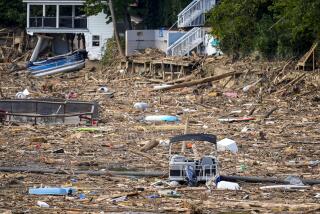Cleaning Up the Scarred Landscape
- Share via
OYSTER, Va. — The sea left calling cards at Kent and Jean Reynolds’ place.
Their manicured green lawn was buried under a mulch field of crushed twigs and debris. Their wood-frame cottage reeked of rot and brine. Six goldfish that once frolicked in their tiny freshwater pond were gone, carried off by Hurricane Isabel.
Unleashed by the storm’s screeching wind, the Atlantic Ocean had swept in over seven miles of low marshland, overwhelming the tiny fishing town of Oyster and postage-stamp communities along Virginia’s remote Eastern Shore. The ocean had already receded as residents emerged Friday to gape at the blasted landscape Isabel left behind and clear away its damage.
“Lord, where did all this stuff come from?” Jean Reynolds gasped as she trudged through a carpet of driftwood that was once her yard.
Her husband fixated on a massive sun-bleached tree limb sunk into the mud. “I know that tree!” he said. “I seen that on an island eight miles from here!”
Hefting chain saws to clear obstructed roads and tree-splintered rooftops, the Eastern Shore’s storm survivors were confronted everywhere by the overwhelming odor of slashed pine and the daunting sight of trees strewn like cardboard. It was much the same in Norfolk’s wind-battered flatlands and in the sea-scoured islands of North Carolina’s Outer Banks -- a broken forest of trees yanked from their roots, marinas and wharves disintegrated by a relentless sea.
All along the peninsula, those who took to the road packed tools and gas cans to help neighbors in need. Some towns had been entirely isolated by crashed branches and downed power lines. “Hot Wire!” warned a sign tacked to a bent telephone pole.
In the Eastern Shore town of Parksley, the wind killed a man -- one of Isabel’s 18 known fatalities -- by heaving a weakened oak on top of a mobile home during the storm’s worst hours Thursday night, said Accomack County Sheriff Robert Crockett.
Thousands of trees were blown down across the peninsula -- far more, Crockett said, than had been felled by Hurricane Floyd in 1999. “We had too much rain this summer,” Crockett said. “The ground was like a sponge, saturated. The wind didn’t even have to push that hard. These trees just keeled over.”
Deputies were unable to follow their regular patrol routes, repeatedly forced to stop to clear tree-obstructed country lanes and aid residents hemmed in by trunks too immense to lift. Small mountains of pulverized brush became roadblocks.
“I got a chain saw in my trunk, but I could’ve used a pitchfork,” said Virginia Marine Police Officer J. T. Parks.
In the town of Machipongo, Kathleen Bono, 39, listened to the whine of her husband Jack’s chain saw while she took measure of a massive oak that had plunged down on her father’s house. She had never even noticed the oak’s spreading top before, but now it was impossible to miss -- a corona of twisted branches that webbed over the roof like an unearthly antenna.
“We thought we could wait this one out, but I’ll never do this again,” she said. Her 14-year-old daughter Krystle had yelped every time the wind howled. “Next time, we’re getting out of town.”
When Parks drove by the Reynolds’ house in Oyster, he mentioned the chain saw he carried in his patrol car trunk. But they were still too dazed to answer, peering at the debris as if guests at some baffling art show.
A fearsome wind gust had driven a branch into a massive oak, cleaving its 3-foot-thick trunk like it was made from pegboard. The branch was still wedged there Friday, an eerie remnant of the storm’s power.
The Reynoldses talked in awe of the ferocious winds. Severe gusts had careered in from the sea most of the day, then began to fade. Television weather forecasters insisted the worst of the hurricane had passed. They were wrong.
The wind suddenly changed course, blowing in from the Chesapeake Bay side. “That’s when Isabel really did a number on us,” Jean Reynolds said.
As the storm approached Thursday, the couple took their usual precautions. Oyster’s small inlet was known to swell during heavy storms so Kent Reynolds, 47, a veteran bay waterman with muttonchops, carried the couple’s computer and television out to his waiting car. Jean, 48, roamed the property with a video camera, filming “for insurance purposes.”
She filmed the Oyster’s inlet whipped up by the wind, its serene waters breaking into tiny whitecaps. The house creaked as the gusts strengthened. But her camera was turned off as the Atlantic Ocean suddenly appeared in the east, rolling toward them across the lowlands, vast, churning, unstoppable.
Kent Reynolds grabbed instinctively at a framed family photograph. Jean ran for their car. By then, the Atlantic was in their kitchen, leaking up through the flooring, pouring in through saturated walls. As they drove off, the entire town of Oyster lay inundated. Piers disappeared. Heavy propane tanks bobbed like rusted apples in the surf.
“It was the creepiest thing I’ve ever seen,” she recalled. “I had breakers in my living room.” They made it to a shelter in the neighboring town of Cheriton, camping out until the wind died to a whimper.
When they returned Friday morning, the sea was seven miles away again. Kent Reynolds kicked at the muddy debris that layered the lawn. Jean poked with a stick at the mud hole where her goldfish once swam. She found only more mud.
“Poor things can’t survive in saltwater,” she said, saddening. “Can you imagine all this was under water? I don’t want to be around here next time that happens.”
More to Read
Sign up for Essential California
The most important California stories and recommendations in your inbox every morning.
You may occasionally receive promotional content from the Los Angeles Times.













